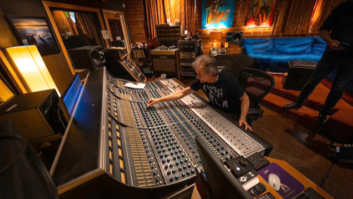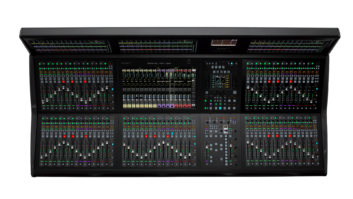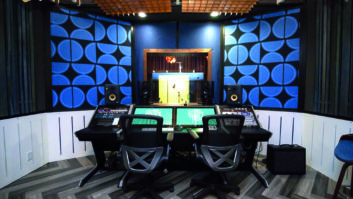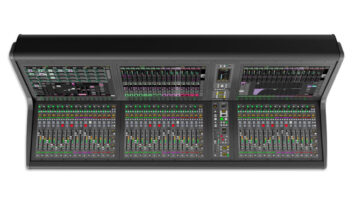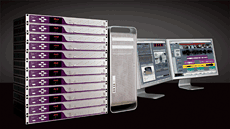

Considering the recent advent of affordable, fast and powerful multi-processor computers hitting the market, and DAW applications with drivers that can take advantage of this power, there is no arguing that native recording is coming on strong. This newfound power gives engineers and production houses more options than ever to get their work done. The hitch in this new way of working doesn’t lie with mixing, where latency isn’t a factor, but with live recording, where delays from input to output can kill a groove. Apogee Electronics conceptualized, engineered and designed a system that takes advantage of Apple’s new multiple processors and PCIe architecture to get in and out of the box with minimal latency.
WE’VE GOT A SYSTEM
The Symphony System combines Apogee X Series or Rosetta Series converters fitted with Apogee’s optional X-Symphony card and a Symphony Express PCIe card. The new Mac Pro tower or a MacBook Pro laptop fitted with the Symphony Mobile card (see “Symphony Mobile System” on page 105) can act as the center of your studio universe. The tower allows up to 96 total channels while the laptop gets you 32. Both need a separate drive for the DAW software and a lightning-quick storage drive to kill the latency beast. Symphony is compatible with any Core Audio-based application; however, for this test I used Logic Pro Version 7.2.3.
The Symphony system comes with Apogee’s Maestro management and mixing software, which I never used during this test because Logic Pro is able to adjust the sample buffer precisely for a session’s needs and has advanced routing capabilities. On top of that, I wanted to be able to maintain real-world workflow by building cues, routing and mixes completely within Logic Pro to see how it would work in this situation. (See “Maestro Software” for more information.)
My test setup included an Apple Mac Pro quad-core computer featuring two quad-core 3GHz processors and four drives total — three 500GB drives striped as RAID 0 for storage and a 500GB system drive. All digital conversion was handled through two Apogee AD-16Xs and two DA-16Xs. The digital I/O was ported to and from the computer via Apogee’s proprietary PC32 digital cable through the first converter, then daisy-chained through the other units, which were fitted with Symphony-X cards. This system lets users configure a total of 32 I/Os through a single PCIe card; I had 32 channels available and used 19 inputs and 28 outputs. All of the converters were clocked from the first unit and then down the chain using BNC connectors. Analog I/O and controller duties were handled via an SSL AWS 900+. The analog inputs were fed into the converters through Mogami Gold ¼-inch TRS to DB-25 from the AWS 900+.
STRIKE UP THE BAND
For this test, I combined tracking and MIDI sequencing. My mission was to replace some sampled tracks with live drums, guitar and bass. The mix comprised a MIDI track that was originally built in GarageBand and then opened in Logic Pro using multiple virtual instruments representing drums, bass, keys and guitar. The song ran virtual instrument emulations of a B3, Rhodes and Clav, as well as a virtual drum kit, bass track and Apple Loop that took up bandwidth but were not monitored. The session also carried a previously recorded live sax track. My tracked drum kit was recorded using 17 mics into the AWS 900+; the guitar and bass were taken direct into the AWS. All instruments were sent to Logic Pro via Symphony.
Because the AWS 900+ has only 24 inputs for mixing, all virtual tracks were brought back in a stereo stem out of Logic, while the live tracks were brought back to their own inputs. In addition, the live tracks and stem were sent to the 5.1 output and the headphone cue for the drummer. My session was held in the Conservatory of Recording Arts’ D Room, which houses five M&K MPS 2510PK speakers and an MPS 5410 sub.
TAKING THE TEST
The first test was to try to max out the system and then backtrack using various buffer settings and sample rates to see how latency and system behavior modified workflow. I started with the system at 24-bit/192kHz and a buffer setting of 256 samples, and proceeded by getting guitar sounds. The player was going directly through the instrument input on the AWS 900+ into Logic Pro. On the guitar’s Logic channel strip, I ran amp emulator, compressor, reverb, rotary speaker and limiter plug-ins. The bass was also taken direct into the AWS instrument input, and I used an EQ plug-in on its channel in Logic. I experimented in this mode assessing latency, which was inaudible, according to the players. However, there was considerable snatting and some drive performance errors at this sample rate, so I opted to knock it down to 24-bit/88.2kHz, with the buffer set to 128 samples (the latency equivalent of 44.1 kHz at 64 samples). At this rate, I experienced no problems.
I was excited and impressed that I could get this level of performance without dedicated DSP or a card cage (the computer and Symphony ably handled those tasks), as well as with a low buffer setting. Keep in mind that I wasn’t simply putting the 19 tracks into record. While recording, I used system-hogging virtual instruments and plug-ins on the guitar and bass tracks, and played back prerecorded audio. I was feeling cocky at this point, so I decided to take the session setting up to 24-bit/176.4kHz and a buffer of 256 samples. The take came off without a hitch, with none of the snatting or drive errors that I saw at 192 kHz earlier.
WORKFLOW IN LOGIC
This isn’t a Logic Pro review per se; however, in reference to native recording, there was some inherent clunkiness in Logic that kept session flow difficult. For instance, whenever I stopped recording to reset levels or do another take, a dialog popped up in Logic telling me that the app was recalculating the waveforms. The time that it takes Logic to do this depends on the session’s sample rate, with higher rates requiring more time. Another feature notifies you of possible audio clipping, with one message for each track that has to be cleared individually. You could ignore these messages and record again, but the AWS 900+ still carried messages on its scribble strips announcing the presence of screen dialog, which prevented me from seeing the track names.
I found a preference to defeat this, but that resulted in having blank regions. The most obvious glitch was that at any sample rate, there was a slight drop-out when punching out — but not punching into — a track. This was only evident during the recording, not after, so it wasn’t going to the drive. Apogee’s view is that it was a Logic issue due to a lack of available voices, but I had plenty of punch on the fly, so I’m not sure if this is a Logic or a Symphony flaw, but it is notable.
IS SYMPHONY A MASTERPIECE?
To be blunt, I got away with murder, considering what I asked this system to perform. I didn’t go crazy with plug-ins, but did use five during tracking. I also used some DSP-intensive Vis and, remarkably, didn’t have to freeze tracks during the session. As detailed in the “Symphony Mobile System” sidebar, I was able to port over to the laptop system easily without a reboot, run the session and record another take without a hitch. The key point here is that the system had enough muscle to pull off a 32-track session on a native system without a card expander or external DSP, while carrying some serious plug-in and VI baggage in tow.
Recording natively saves some considerable cash over other established alternatives, giving the user a great degree of freedom. Plug-ins are cheaper by a long shot, and you can use most any DAW software you’d like. Symphony is certainly a contender for the native crown: This all-in-one system finally provides the horsepower necessary to get the job done, whether you’re mixing or tracking. Prices: X-Symphony Card, $200; Symphony PCI card, $795; Symphony Mobile $595; and AD-16X or DA-16X, $3,495.
Apogee Electronics, 310/584-9394, www.apogeedigital.com.
Kevin Becka would like to thank Logic guru Robert Brock, Ryan Baumann from GC Pro, Dave Casey from Apogee, Tony Kinchion (guitar), Rob Wagener (bass), John Lewis (drums) and a cast of Conservatory of Recording Arts interns for their help.
Maestro Software
Included with Symphony, Maestro software lets you handle some essential tasks, including the ability to control hardware ins and outs from the computer to Symphony (or Symphony Mobile), route audio between — or even within — DAW apps via Apogee’s VBus, and adjust settings for low latency with its Performance Tuning feature. There’s also a mixer that blends the hardware inputs with your DAW’s returns and sends this to the hardware outputs. This is all performed while your DAW is running.
On the practical side, Maestro can take over when your app does a poor job with latency or offers insufficiently low buffer settings, such as in GarageBand; it could also be used for low-latency cue sends. Logic Pro users will love the fact that Maestro lets you take advantage of Apogee’s VBus. Before, you couldn’t perform bounces back to an audio track and record them in Logic, but with the VBus, you can send it out of your source tracks and invite it into your target tracks, all on VBuses (up to 32).
Maestro is a nice friend to have around in the studio for a number of critical jobs, should your setup need the help. However, if you’re using major DAWs such as SONAR, Digital Performer, Nuendo, BIAS Peak and Logic Pro, you should not need it.
— Kevin Becka
Symphony Mobile System
If you want to take your native Apogee system on the road, then the Symphony Mobile System might just be the ticket. Compatible with any Apple MacBook Pro, the system features 32 channels of 24-bit/192kHz digital I/O boasting 1.6 milliseconds of latency at 96k. It connects to the laptop’s Symphony Mobile card (which has the same bandwidth as the X-Symphony card) via a single PCI-32 cable and then to Apogee’s Rosetta 800, Rosetta 200, and AD-16X and DA-16X converters via the optional X-Symphony card. It is compatible with any Core Audio software application and includes Apogee’s Maestro software for controlling, routing and accessing Core Audio’s VBus for virtual routing between or within applications.
To port this test over to the Symphony Mobile System, Dave Casey from Apogee provided an Apple MacBook Pro with Intel Core 2 Duo processors running at 2.33 GHz and fitted with a Symphony Mobile card. I could hot-plug the cable from the X-Symphony card to the Symphony Mobile card without a reboot. I then re-booted the Mac Pro tower in Target mode so I was tapping off the tower’s RAID to the laptop through the FireWire 800 port. I brought the session to 24-bit/88.2kHz with a buffer size of 128 samples and ran a take playing back all virtual tracks and recording the live band. Impressively, it came off without a hitch with no drive errors or noises.
According to the performance meter, I was on the edge of CPU power, but it had no effect on the recording. Of course, had I run into a glitch, I could have frozen the virtual tracks making the load even easier on the laptop’s processor, yet this wasn’t necessary at this sample rate and buffer setting.
I also tried recording all 32 tracks at once without plug-ins or Vis, and the system pulled it off like a champ. This bodes well for those looking for a dual-duty recording solution that could be taken into the field and then brought back to the studio and simply plugged into a tower for mixing or sweetening. This review was a winner all the way around.
— Kevin Becka

WATCH: The Flow Chart



